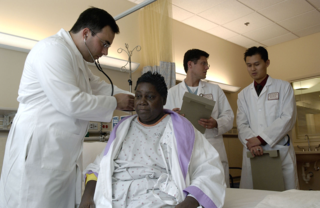 As hospitals focus efforts on reducing the number of hospitalizations and patients who are readmitted to the hospital within 30 days to avoid financial penalties from the Centers for Medicare and Medicaid Services, so-called “observation stays” have risen. These short-term hospitalizations are typically used when outpatients need to be followed to determine if they require treatment as inpatients, or if they can be safely discharged to their homes. Some examples of conditions that may lead to an observation stay are: nausea, vomiting, weakness, stomach pain, headache, fever, and some types of chest pain. Recent data showing an increase in observation stays over the last three to four years has some expressing concerns about financial repercussions for Medicare patients. However, a Viewpoint recently published in JAMA by Perelman School of Medicine student Giffin Daughtridge and Traci Archibald and Patrick Conway, MD, MSc, of the Center for Medicare and Medicaid Services, says there are more positive signs in the bigger picture.
As hospitals focus efforts on reducing the number of hospitalizations and patients who are readmitted to the hospital within 30 days to avoid financial penalties from the Centers for Medicare and Medicaid Services, so-called “observation stays” have risen. These short-term hospitalizations are typically used when outpatients need to be followed to determine if they require treatment as inpatients, or if they can be safely discharged to their homes. Some examples of conditions that may lead to an observation stay are: nausea, vomiting, weakness, stomach pain, headache, fever, and some types of chest pain. Recent data showing an increase in observation stays over the last three to four years has some expressing concerns about financial repercussions for Medicare patients. However, a Viewpoint recently published in JAMA by Perelman School of Medicine student Giffin Daughtridge and Traci Archibald and Patrick Conway, MD, MSc, of the Center for Medicare and Medicaid Services, says there are more positive signs in the bigger picture.
The authors reveal several ways in which Medicare coverage differs for inpatient hospitalizations and outpatient observation stays: Outpatient visits carry a 20 percent co-pay, and coverage for outpatients does not include some services that are covered for inpatients, including self-administered medications. A recent article from the New York Times also reports that regardless of length, observation stays do not count toward Medicare’s requirement that a patient must have a hospital stay of three consecutive days in order for any post-hospitalization rehabilitation services to be covered. The article cites one patient who fractured her hip and was admitted to the hospital for observation while doctors determined whether the injury would require surgery. It did not, and she was discharged a few days later. Though she was cared for at the hospital, she was not officially admitted as an inpatient. As a result, the costs of any treatment she received while in the hospital and subsequent rehabilitation to aid with her pain and mobility was not covered by her Medicare insurance.
“Classification as an inpatient versus outpatient is important because of the different Medicare coverage and reimbursement rates,” said Daughtridge. “While the concern that these classifications can unexpectedly cost patients a lot of money is legitimate, research has shown that short observation stays may be less costly to the patient than short inpatient stays. As a result, further research is needed to understand the financial implications to Medicare beneficiaries of increasing observation rates so that policy can be implemented to benefit both the national health care system and the beneficiaries.”
In the paper, Daughtridge and co-authors found that the rate of observation stays (per 1,000 Medicare patients) increased from 39 in 2009-2010 to 49 in 2012-2013. However, although observation stays are on the rise, the more dramatic change is in the decreasing numbers of inpatient hospitalizations, which fell from 314 in 2009-2010 to 284in 2012-2013. Combined, the nation saw a 5.7 percent decline in patients being admitted to the hospital, as either an inpatient or outpatient.
Despite concern about increasing observation rates, Daughtridge says the substantial decreases in overall hospital utilization (hospitalizations and observation stays) in the Medicare population is promising. The authors cite successful quality improvement efforts and policy changes aimed at improving population health and quality of care as a main contributing factor for the changes. Specifically, community-based transition groups that focus on identifying local causes of poor care and implementing programs to address those root causes have proven to be particularly beneficial.
At Penn Medicine, clinicians, patients, and caregivers worked together to developed IMPaCT™, a comprehensive, evidence-based program created to advance the integration of evidence-based Community Health Worker (CHW) models into healthcare delivery. CHWs hired from within the local community help patients to navigate the health care system and address key health barriers, such as housing instability or food insecurity. A study published in JAMA Internal Medicine earlier this year from researchers in the Penn Center for CHWs reported that this intervention improves both patient experiences and health outcomes, while reducing repeat hospital readmissions. The Center is rapidly growing and will employ 30 full-time faculty and staff by the end of 2014.
Results of other studies have also indicated that similar interventions are successfully reducing hospitalization rates for the individuals they serve.
“As community-based programs expand, the expectation is that there will be further improvements in the quality of care transitions and reductions in hospitalizations,” said Daughtridge. “The recent decrease in total hospitalizations points to very specific and promising efforts that are keeping patients healthy and out of the hospital. Hopefully these results will eventually have the same effect on observations stays as well.”